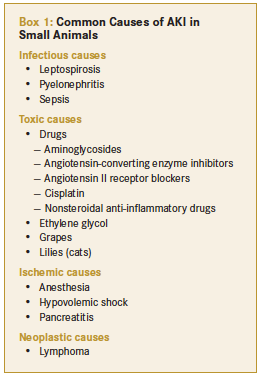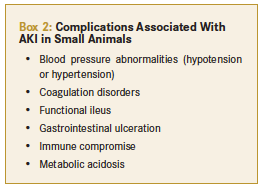Acute Kidney Injury in Dogs and Cats
Timely recognition of this potentially severe disease and management of associated complications are critical for patient comfort and treatment success.

According to Sarah Steinbach, DrMedVet, DACVIM, DECVIM, an assistant professor and director of the Purdue Veterinary Hemodialysis Service at Purdue University College of Veterinary Medicine in West Lafayette, Indiana, acute kidney injury (AKI) can be a serious disease that may carry a poor prognosis.
Presenting at the 2018 Purdue Veterinary Conference, which was held on the Purdue University campus in September, Dr. Steinbach emphasized the need to “recognize that AKI represents a wide spec­trum of disease,” ranging from mild (without azotemia) to severe (with high-grade azotemia and serious clini­cal manifestations). Additionally, animals can go back and forth on the spectrum of disease severity during an AKI event, depending on how the animal is being treated, she noted. “It is a very dynamic disease.”
DIAGNOSIS AND STAGING
In most cases, Dr. Steinbach said, veterinarians are unable to identify the cause of AKI, despite extensive laboratory testing. However, some of the most commonly reported causes of AKI in small animals have infectious, toxic, ischemic, or neoplastic origins (Box 1).

A staging system now exists for veterinary patients with AKI,1,2 Dr. Steinbach said, and this provides a mechanism to help identify animals with AKI and stage their disease. However, she noted, no treatment recommendations are currently available to help guide the management of these patients.
Dr. Steinbach stressed that AKI is a multiorgan disease because the kidney affects many body systems (Box 2). For example, about 80% of dogs with AKI develop hypertension, she said. So the treatment plan must also be wide rang­ing to address associated problems such as hypertension and gastroin­testinal ulceration.
Indeed, the many complications that can arise in animals with AKI point to the intensive care needs of patients with this condition. This disease can-not typically be managed on an outpatient basis, she noted.
TREATMENT
Overall, timely recognition of AKI and management of its associated complications are critical for patient comfort and treatment success. Veterinarians should treat the primary cause of the AKI, if it is known, Dr. Steinbach said. Otherwise, treatment should aim to support the animal while its kidneys heal.
Although the goal is to restore and maintain hydra­tion in animals with AKI, she cautioned veterinarians to take care to avoid fluid overload in these patients. “In 99.9% of [cases] when we have excessive edema in these patients, it’s our fault,” she emphasized, “because we give them too much fluid.”
Fluid overload is bad, she explained, adding that in dogs, “the odds ratio for death increases by 1.08 with each 1% increase in fluid overload.”3 In critically ill people with AKI, fluid overload is independently asso­ciated with mortality, Dr. Steinbach said, sharing the results of a study in which patients with fluid overload at the time of their peak level of serum creatinine were significantly less likely to recover kidney function.4 “You cannot just ‘flush’ the kidneys,” she stressed. Fluid diuresis does not improve the animal’s glomeru­lar filtration rate.
If fluid therapy fails to restore urine output in veter­inary patients with AKI, diuretic therapy may be used. In human medicine, diuretic therapy is contrain­dicated in such cases, Dr. Steinbach said, and these patients undergo hemodialysis.

However, because hemodialysis is not always an option for small animal patients, she noted, diuretic therapy may be used. Nevertheless, because it is the best-practice treatment in these instances, the patient should undergo hemodialysis if an owner is able and willing to choose this option. In particular, in patients with AKI, insufficient urine output that results in either fluid reten­tion and edema or hyperkale­mia is an absolute indication for hemodialysis.
“The earlier we can intervene with dialysis, the better for the patient,” Dr. Steinbach stressed.
Although no data are currently available to support this in veterinary patients, the approach is recom­mended based on results of studies in human patients, she concluded.
References
- Thoen ME, Kerl ME. Characterization of acute kidney injury in hospitalized dogs and evaluation of a veterinary acute kidney injury staging system. J Vet Emerg Crit Care (San Antonio). 2011;21(6):648-657. doi: 10.1111/j.1476-4431.2011.00689.
- IRIS grading of acute kidney injury (AKI). International Renal Interest Society website. iris-kidney.com/guidelines/grading.html. Published 2016. Accessed September 21, 2018.
- Cavanagh AA, Sullivan LA, Hansen BD. Retrospective evaluation of fluid overload and relationship to outcome in critically ill dogs. J Vet Emerg Crit Care (San Antonio). 2016;26(4):578-586. doi: 10.1111/vec.12477.
- Bouchard J, Soroko SB, Chertow GM, et al; Program to Improve Care in Acute Renal Disease (PICARD) Study Group. Fluid accumulation, survival and recovery of kidney function in critically ill patients with acute kidney injury. Kidney Int. 2009;76(4):422-427. doi: 10.1038/ki.2009.159.
Dr. Parry, a board-certified veterinary pathologist, grad­uated from the University of Liverpool in 1997. After 13 years in academia, she founded Midwest Veterinary Pathology, LLC, where she now works as a private consultant. Dr. Parry writes regularly for veterinary organizations and publications.
